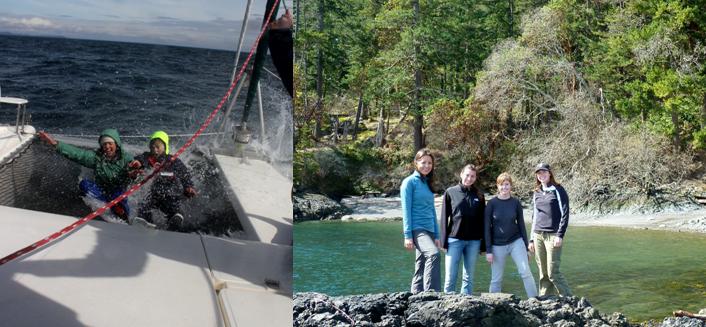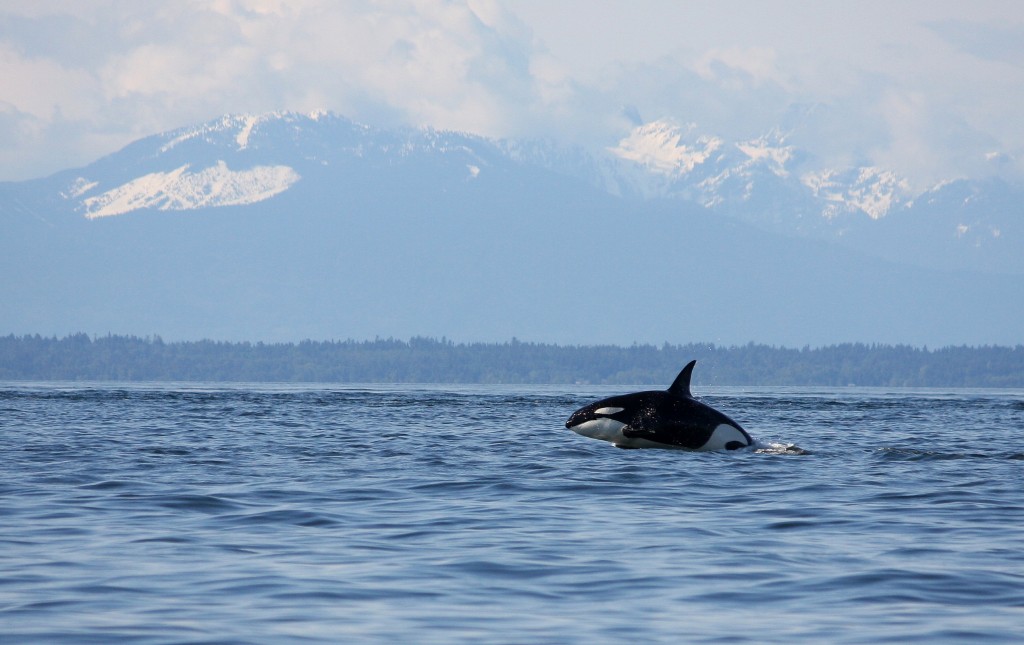Four new student papers and presentations are now posted on the spring 2011 class home page as PDFs and on-line videos. The titles of the student projects are listed below, along with the embedded video of their 10-15-minute talks.
- Introduction by Scott Veirs and Robin Kodner
Introduction by Scott Veirs and Robin Kodner to final presentations of the spring 2011 program at the Beam Reach Marine Science and Sustainability School, including first showing of a highlight video by Carlos Javier Sanchez (streamed and recorded on 6/3/11 at the University of Washington’s Friday Harbor Laboratories)
- Variation in Southern Resident Killer Whale Acoustic Signals in Relation to Environmental Factors (Mandy Bailey, University of Maine)
Final presentation by Mandy Bailey of the spring 2011 program at the Beam Reach Marine Science and Sustainability School (6/3/11 at the University of Washington’s Friday Harbor Laboratories)
- Bottom-up Analysis of Lower Trophic Levels within Foraging Areas of the Southern Resident Killer Whales (Kelsey Donahue, Western Washington University)
Final presentation by Kelsey Donahue of the spring 2011 program at the Beam Reach Marine Science and Sustainability School (6/3/11 at the University of Washington’s Friday Harbor Laboratories)
- Variation in the S1 Call Type of Southern Resident Killer Whales (Emalie Garcia, Texas A&M University)
Final presentation by Emalie Garcia of the spring 2011 program at the Beam Reach Marine Science and Sustainability School (6/3/11 at the University of Washington’s Friday Harbor Laboratories)
- Determining the correlation between call frequency and matriline density in Southern Resident killer whales (Ally Meyer, University of Washington)
Final presentation by Ally Meyer of the spring 2011 program at the Beam Reach Marine Science and Sustainability School (6/3/11 at the University of Washington’s Friday Harbor Laboratories)
Read More
Today was the day of our final presentations. After a solid week of limited sleep (one night I went to bed at 3:30 AM, and I was the first one) and lots of work, it’s a relief to finally have all that stress lifted off our shoulders. It’s given me a chance to really think about our time here. It’s had its ups and downs. When you’re living in a confined space for an extended period of time with the same people, morale can quickly spiral downwards. The final deadline looming over our heads definitely made for some stress. However, most of our boat life was extremely enjoyable. It won’t be the stressful times that we’ll remember when looking back on this trip, it will be all the times that we really enjoyed. There are a lot of things that I will really miss:
1)     Rough seas. The was nothing quite like sitting on the trampoline, rising up on the crest of a large wave only to watch with mild horror as the water simply disappeared underneath you for a minute before rushing up to soak you before you had a chance to even comprehend what’s going on. Rough seas were also fun in the cabin. Whenever Captain Todd yelled in, “You might want to hold on and secure loose items,†a frantic response was initiated as everyone rushed to grab onto their possessions. Then the boat pitched and wreaked more havoc on the galley than a small earthquake. Sure, it could be nauseating. But as long as your computer didn’t crash to the ground (which did happen on more than one occasion), you couldn’t help but laugh.
2)     Sitting out on the trampoline. It was definitely my favorite place on the boat. It was also a great place to nap. It was so relaxing sitting out there, scanning the water for whatever might be out there.
3)     How sweet chocolate tasted on the boat. I swear, chocolate never tasted so good. Especially those NOLS malt balls.
4)     Finding shrimp swimming around in the toilet. I kid you not, it happened. Then you’d have to scoop him out because you didn’t want to condemn him to a miserable death in the sewage tank.
5)Â Â Â Â Â Stirring up the water out the escape hatch at night and watching the Noctiluca produce bioluminescence.
6)Â Â Â Â Â How gorgeous the stars were every night.
7)     Calling every whale watch operator we could think of in the morning in a desperate attempt to find the whales. These calls would sometimes turn into very pleasant chats, and we all made friends with the operators.
8)     Being able to plot our own course every day. If we wanted to go around Whidbey Island, we could. And did.
9)Â Â Â Â Â How good a hot shower felt after a week of feeling cold and dirty all the time.
10)Â Sea hair.
11)Â Discovering new plankton names that sound like dinosaurs.
12) How cold it was every night… oh wait, no I won’t miss that.
13)Â The Aladdin lamp.
14) How beautiful everything out here is. We had the opportunity to visit so many awesome places, from Deception Pass to Active Pass way up in Canada. Each adventure was more exciting and beautiful than the last.
15) Home-cooked popcorn. Who knew it was so much better than microwave popcorn?
16) The whales, of course. Let me tell you, there is nothing more exciting than seeing that first blow and then getting to spend hours with these amazing animals. To make it even better, we got to listen to them underwater as we were observing them above water as well. Every day that we spent with the whales became my “best day ever.â€
17) All the amazing people that I met. I’d like to give a special thanks to all of the guest speakers that took time out of their busy schedules to meet with us. It’s been amazing. Also, to Ally, Emalie and Kelsey for helping to make this experience fun. I’ll miss them all terribly, and hope that I’ll get to see everyone again sometime in the future.
This program has been a really great opportunity. It has given us an intimate taste of what field research is like, and has definitely helped me to shape my future path. We’ve all learned so much, and I’m excited to be able to share this newly acquired knowledge with others. For a really great video on Beam Reach made by our fantastic videographer, Carlos, check this out. It’s a good summary of our experience.
I’ve wanted to study whales ever since I was three years old and first watched the movie ‘Free Willy’. I was extremely lucky to get the opportunity to actually do this. If you ever get such an opportunity to follow your dream, go for it. You never know what you might find.

Transient orca

Read More
Today was the last day of Beam Reach! We have all worked so hard to get to this point and I think our efforts have paid off. Our presentations went smoothly and we immediately dispersed to our families and homes that are all across the country.  I decided that my last blog should be a summary of my independent project of the course because I have failed to mention it so far. My project looked at the ecological significance of the Southern Resident killer whales. When looking at the trophic interactions that are involved in their food chain it is apparent that bottom up analyses is understudied. Most people seem to look at top down control of the Southern Residents such as what negative impacts are directly affecting the whales. Not many studies seem to focus on how primary productivity affects their population. Here is a graph I used in my presentation that illustrates the trophic interactions that are involved in the Southern Resident killer whale food chain.  The Southern Residents are known to primarily eat chinook salmon. Chinook salmon eat forage fish. The forage fish eat zooplankton and the zooplankton eat phytoplankton. These interactions led to my hypothesis trying to find a linear relationship between primary productive ‘hotspots’ or areas of high amount of phytoplankton and presence of fish. My sample sites were on the west side of San Juan Island and over Salmon Bank. I concluded my project and presentation with insignificant differences between phytoplankton abundance between sites and the absence of large targets. This does not mean that there isn’t a linear relationship between the two. It implies that environmental factors that can drive variation in phytoplankton abundance within our transect of study was insignificantly different between sites. Therefore future methods were suggested to contain another transect with different tidal patterns so  primary productive hotspots or significant differences in abundance of phytoplankton could be found. If anyone wants to look at each of our presentations you can go to the beam reach website at http://www.beamreach.org/class/2011-spring and our talks should be up there soon! Well this is it…have a great summer everyone!
The Southern Residents are known to primarily eat chinook salmon. Chinook salmon eat forage fish. The forage fish eat zooplankton and the zooplankton eat phytoplankton. These interactions led to my hypothesis trying to find a linear relationship between primary productive ‘hotspots’ or areas of high amount of phytoplankton and presence of fish. My sample sites were on the west side of San Juan Island and over Salmon Bank. I concluded my project and presentation with insignificant differences between phytoplankton abundance between sites and the absence of large targets. This does not mean that there isn’t a linear relationship between the two. It implies that environmental factors that can drive variation in phytoplankton abundance within our transect of study was insignificantly different between sites. Therefore future methods were suggested to contain another transect with different tidal patterns so  primary productive hotspots or significant differences in abundance of phytoplankton could be found. If anyone wants to look at each of our presentations you can go to the beam reach website at http://www.beamreach.org/class/2011-spring and our talks should be up there soon! Well this is it…have a great summer everyone!
Read More






 Twitter
Twitter LinkedIn
LinkedIn Facebook
Facebook